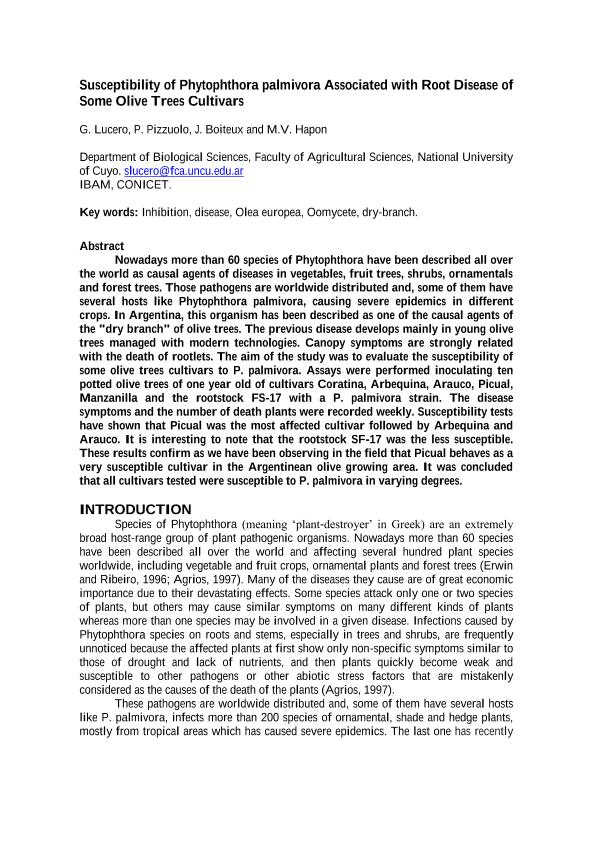Artículo
Susceptibility of phytoohthora palmivora associated with root disease of some olive trees cultivars
Fecha de publicación:
10/2014
Editorial:
International Society for Horticultural Science
Revista:
Acta Horticulturae
ISSN:
0567-7572
Idioma:
Inglés
Tipo de recurso:
Artículo publicado
Clasificación temática:
Resumen
Nowadays more than 60 species of Phytophthora have been described all over the world as causal agents of diseases in vegetables, fruit trees, shrubs, ornamentals and forest trees. Those pathogens are worldwide distributed and, some of them have several hosts like Phytophthora palmivora, causing severe epidemics in different crops. In Argentina, this organism has been described as one of the causal agents of the “dry branch” of olive trees. The previous disease develops mainly in young olive trees managed with modern technologies. Canopy symptoms are strongly related with the death of rootlets. The aim of the study was to evaluate the susceptibility of some olive trees cultivars to P. palmivora. Assays were performed inoculating ten potted olive trees of one-year-old cultivars ‘Coratina’, ‘Arbequina’, ‘Arauco’, ‘Picual’, ‘Manzanilla’ and the rootstock FS-17 with a P. palmivora strain. The disease symptoms and the number of dead plants were recorded weekly. Susceptibility tests have shown that ‘Picual’ was the most affected cultivar followed by ‘Arbequina’ and ‘Arauco’. It is interesting to note that the rootstock SF-17 was the less susceptible. These results confirm what we have been observing in the field that ‘Picual’ behaves as a very susceptible cultivar in the Argentinean olive growing area. It was concluded that all cultivars tested were susceptible to P. palmivora in varying degrees.
Palabras clave:
Disease
,
Oomycete
,
Olea Europea
,
Dry-Branch
,
Inhibition
Archivos asociados
Licencia
Identificadores
Colecciones
Articulos(IBAM)
Articulos de INST.DE BIOLOGIA AGRICOLA DE MENDOZA
Articulos de INST.DE BIOLOGIA AGRICOLA DE MENDOZA
Citación
Lucero, Gabriela Susana; Pizzuolo, Pablo Humberto; Boiteux, Joana Jaqueline; Hapon, María Vanda; Susceptibility of phytoohthora palmivora associated with root disease of some olive trees cultivars; International Society for Horticultural Science; Acta Horticulturae; 1057; 10-2014; 431-436
Compartir
Altmétricas




